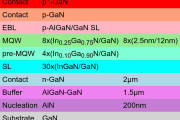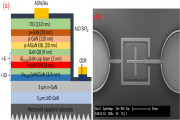 2024-12-06
2024-12-06
South China University of Technology and Guangdong Choicore Optoelectronics Company Ltd in China report on using graded indium gallium nitride (InGaN) quantum barriers (QBs) in blue light-emitting diode (LED) to improve the modulation frequency performance of devices grown on silicon (Si) with a view to deployment in visible light communication (VLC) systems [Lei Lei et al, IEEE Electron Device Letters, published online 11 November 2024]. The team sees VLC as a potential supplement to the overcrowded spectrum of existing wireless communication systems. ...
Continue reading →
 2024-10-25
2024-10-25
Researchers based in China report the growth of high-brightness green indium gallium nitride (InGaN) light-emitting diodes (LEDs) on silicon (Si) [Haifeng Wu et al, Light: Science & Applications, v13, p284, 2024]. The epitaxial material was fabricated into normal-size LEDs and arrays of 5μm pixels at 7.5μm pitch in a 1080x780 format. A 30x30 array reached a brightness of 1.2x107cd/m2 (nits) at 1000A/cm2 current injection, claimed as the highest reported for such micro-LEDs.
The research team from Hunan University, Innovision Technology (Suzhou) Co L...
Continue reading →
 2024-10-07
2024-10-07
LED product and lighting maker Lumileds LLC of San Jose, CA, USA claims to be first to demonstrate that rich deep red light (615nm dominant wavelength corresponding with 635nm peak) can be produced with indium gallium nitride (InGaN) LEDs, achieving a wall-plug efficiency of 7.5% at a current density of 10A/cm2. The firm says that its breakthroughs address the challenges associated with high indium concentrations, including spectral peak shifts and broadening with current density.
The InGaN material system is an attractive alternative to aluminium indium galliu...
Continue reading →
 2024-06-28
2024-06-28
University of Wisconsin-Madison in the USA reports on atomic layer deposition (ALD) passivation as a means to overcome the impact of sidewall damage on micron-scale light-emitting diodes (micro-LEDs), resulting in near size-independent performance between 8μm and 100μm [Guangying Wang et al, physica status solidi (RRL) published online 23 May 2024].
The researchers comment on smaller devices: “Micro-LEDs have the potential to show higher stability under high current density while providing a higher light extraction efficiency and output power than regula...
Continue reading →
 2023-12-22
2023-12-22
Tsinghua University and Beijing National Laboratory for Condensed Matter Physics in China have reported on the use of freestanding gallium nitride substrates (FGS) for red indium gallium nitride (InGaN) micro-light-emitting diodes (LEDs) in terms of efficiency and uniformity across arrays of devices [Luming Yu et al, Appl. Phys. Lett., v123, p232106, 2023]. The researchers claim that InGaN red micro-LEDs with etching-defined mesa size <5μm have not previously been reported.
Although it is difficult to achieve high efficiency using indium gallium nitrid...
Continue reading →
 2021-10-29
2021-10-29
Together with collaborators at the Massachusetts Institute of Technology (MIT), National University of Singapore (NUS) and Nanyang Technological University (NTU), researchers at the Low Energy Electronic Systems (LEES) Interdisciplinary Research Group (IRG) at Singapore-MIT Alliance for Research and Technology (SMART, a partnership between the Massachusetts Institute of Technology and the National Research Foundation of Singapore) have discovered a new method of generating long-wavelength (red, orange and yellow) light through the use of in...
Continue reading →
 2021-09-10
2021-09-10
University of California Santa Barbara (UCSB) in the USA suggests that indium gallium nitride (InGaN) red micro-sized light-emitting diodes (μLEDs) could provide a solution for displays [Panpan Li et al, Appl. Phys. Lett., v119, p081102, 2021].
Although the high indium content leads to relatively low external quantum efficiency (EQE) compared with commercial aluminium indium gallium phosphide (AlInGaP) regular-size LEDs, which can reach 20-30%, the UCSB research shows that the InGaN devices maintain their ~2.5% EQE as the dimensio...
Continue reading →
 2021-09-03
2021-09-03
Ohio State University and Sandia National Laboratories in the USA claim the first demonstration of triple-junction cascaded III-nitride light-emitting diodes (LEDs) grown by metal-organic chemical vapor deposition (MOCVD) [Zane Jamal-Eddine et al, Appl. Phys. Express, v14, p092003, 2021]. Stacking LEDs is one way to overcome the limitations in output power density imposed by the effects of efficiency droop at large current density. Tunnel-junction (TJ) structures are used to connect LEDs since they enable electron majority carriers to be transformed to ...
Continue reading →
 2017-06-22
2017-06-22
Using what it calls the “most recent ultra-bright InGaN chip technology”, Vishay has announced green 0603 leds producing up to 2.8cd (or 2,800mcd as it puts it).
Continue reading →
 2015-06-29
2015-06-29
The latest research from the Niels Bohr Institute shows that LEDs made from nanowires will use less energy and provide better light. The researchers studied nanowires using X-ray microscopy and with this method they can pinpoint exactly how the nanowire should be designed to give the best properties. The results are published in the scientific journal, ACS Nano.
Continue reading →
2009-03-11
AIXTRON AG reported that in the fourth quarter 2008 the National Taiwan University (NTU) of Taiwan ordered one Close Coupled Showerhead 3x2" wafer Research Platform MOCVD system for research and development on GaN and related materials and devices and it will be delivered in the third quarter 2009.
Continue reading →
2008-11-05
It’s reported that Intematix Corp.has added an amber-color LED family to its growing line of packaged device solutions. Its new amber-color product line leverages Intematix' patented phosphor technologies in combination with InGaN blue LED chips to create the breakthrough product family. Blue-excited amber LEDs offer substantial increases in efficiency and temperature stability compared to traditional AlInGaP-based amber LED technologies. Follow-on blue-excited color LED families are also under development.
Continue reading →
 2024-12-06
2024-12-06
 2024-10-25
2024-10-25
 2024-10-07
2024-10-07
 2024-10-07
2024-10-07
 2024-06-28
2024-06-28
 2023-12-22
2023-12-22
 2021-10-29
2021-10-29
 2021-09-10
2021-09-10
 2021-09-03
2021-09-03
 2017-06-22
2017-06-22
 2015-06-29
2015-06-29